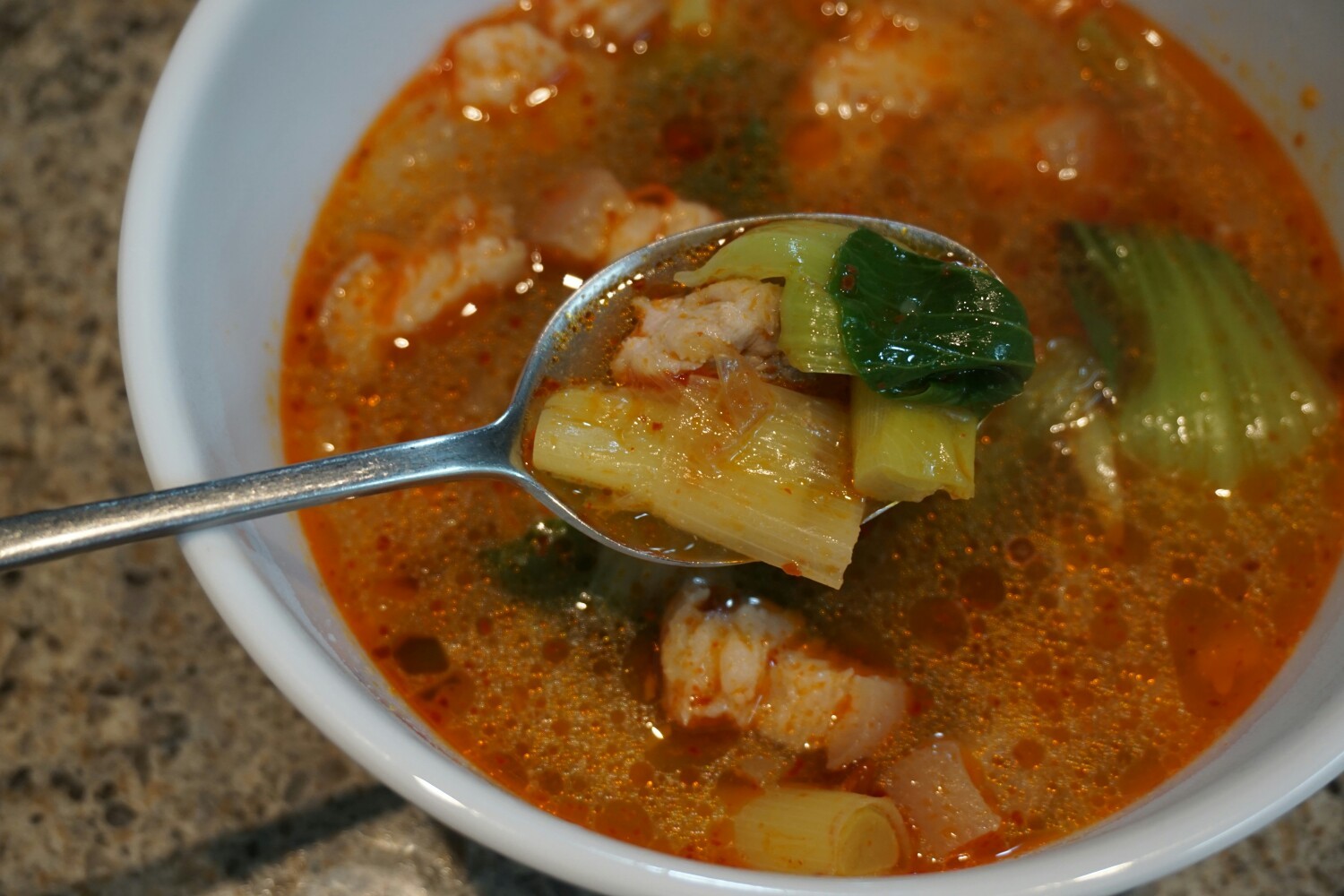Chef Oh Se-deuk Style Pork and Vegetable Stew (Dwae-Sae Jjigae)
Adaptation of ‘Please Take Care of the Refrigerator’ Recipe: Chef Oh Se-deuk’s Dwae-Sae Jjigae

This is my take on Chef Oh Se-deuk’s recipe, which I personally love! The original ‘Please Take Care of the Refrigerator’ recipe uses pork belly, but I’ve opted for pork shoulder for a deeper flavor profile. Instead of wood ear mushrooms, which were included for texture in the original, I’ve substituted my favorite bok choy for a fresher, healthier twist. This stew is so delicious with its rich broth that it’s sure to make you finish a whole bowl of rice in no time!
Stew Ingredients- Pork shoulder or pork belly, 3 strips (approx. 200g)
- Onion, 1/2 medium
- Green onion, 1 stalk
- Minced garlic, 1 Tbsp
- Bok choy, 2-3 heads (substitute for wood ear mushrooms)
Seasoning and Chili Oil Ingredients- Cheongyang chili pepper, 1
- Minced garlic, 1 tsp
- Cooking oil, 3 Tbsp
- Gochugaru (Korean chili flakes), 2 Tbsp
- Soy sauce (soup soy sauce or regular)
- Fermented salted shrimp (saeu-jeot), 1/2 Tbsp (or to taste)
- Water, 500ml (or broth)
- Cheongyang chili pepper, 1
- Minced garlic, 1 tsp
- Cooking oil, 3 Tbsp
- Gochugaru (Korean chili flakes), 2 Tbsp
- Soy sauce (soup soy sauce or regular)
- Fermented salted shrimp (saeu-jeot), 1/2 Tbsp (or to taste)
- Water, 500ml (or broth)
Cooking Instructions
Step 1
Heat 1 Tbsp of cooking oil in a pot over medium-low heat. Add the coarsely chopped onion and sauté until translucent. Drawing out the natural sweetness of the onion is key.

Step 2
Once the onion is softened, add the chopped green onion and stir-fry together for about 1-2 minutes. This process will create a fragrant green onion oil, infusing the dish with its aroma.

Step 3
Add the pork shoulder (or pork belly), cut into bite-sized pieces (about 3cm), to the pot. Sauté until the surface of the meat turns white.

Step 4
Add 1 Tbsp of minced garlic and stir-fry with the pork for another minute. This step ensures the garlic’s fragrance is well incorporated without burning.

Step 5
Pour 500ml of water (or anchovy-kelp broth) into the pot. Once it comes to a boil, skim off any impurities that rise to the surface for a cleaner broth.

Step 6
As the stew starts to boil vigorously, meticulously skim off any foam or impurities using a ladle. This step is crucial for achieving a clear and refreshing broth.

Step 7
While the stew is simmering, prepare the chili oil. In a small bowl, combine 2 Tbsp of cooking oil, 2 Tbsp of gochugaru, 1 tsp of minced garlic, and 1 finely chopped Cheongyang chili pepper.

Step 8
Mix these ingredients well, then microwave for about 1 minute and 30 seconds to 2 minutes (adjust time based on microwave wattage). This creates a flavorful and spicy chili oil without needing to use the stovetop.

Step 9
Once the stew has simmered and the pork is tender, add soy sauce (soup soy sauce or regular) for seasoning. Start with a small amount and adjust to your taste.

Step 10
After seasoning with soy sauce, add fermented salted shrimp (saeu-jeot) to enhance the umami and finalize the taste. Saeu-jeot adds depth to the broth, so adjust the amount according to your preference.

Step 11
Finally, add the washed and chopped bok choy. Bok choy can become mushy if overcooked, so it’s best to cook it for just 1-2 minutes to maintain its crisp texture.

Step 12
Transfer the finished stew to a serving bowl, making it look as appetizing as possible.

Step 13
Generously spoon the prepared chili oil over the stew, including the solids for extra flavor and visual appeal. This not only looks great but also significantly enhances the taste.

Step 14
Serve the stew with hot rice and mix everything together to enjoy. It’s also delicious spooned over rice!

Step 15
Wow! It’s spicy like Yukgaejang, yet the deep flavor of the pork and the refreshing taste of the vegetables create a rich and satisfying stew. It’s a perfect rice thief!




